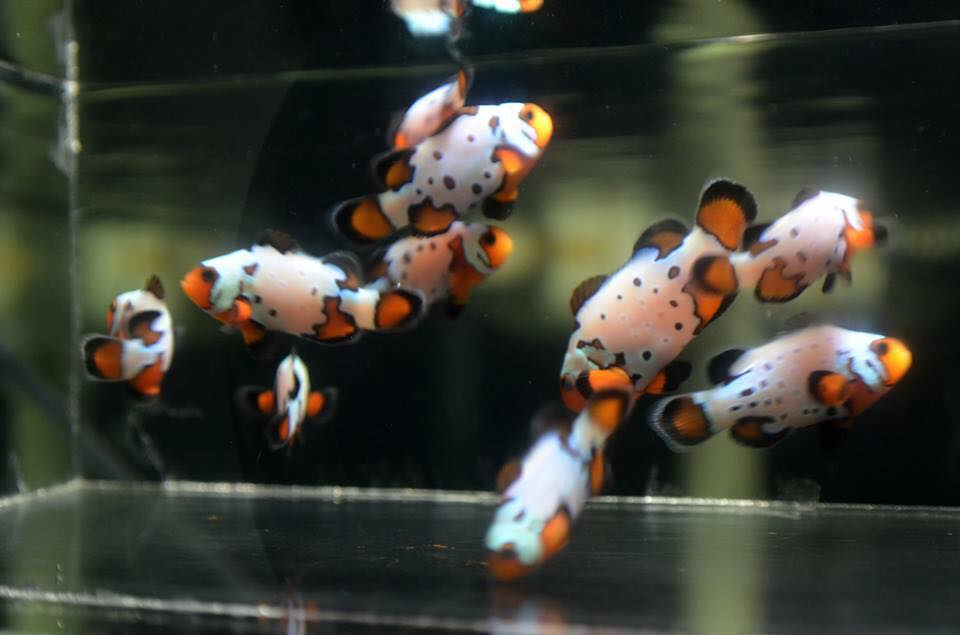ClowfishDepot.com has started offering one of the latest permutations of designer hybrid clownfishes, the Mocha Frostbite.
It didn’t take rocket science to create this new variation. At its core, the Mocha hybrid has been around for over a decade, being the hybrid of the typical orange Amphiprion ocellaris, mated to the Black and White “Darwin” form currently attributed to the same species. Several years ago now, breeders introduced the likely dominant Snowflake gene into the Mocha hybrid by substituting a Snowflake A. ocellaris instead of a wild-type, 3 striped parent; the results of that mating produces both Mochas and the fish we know routinely refer to as Black Ice (although this snowflake-carrying Mocha hybrid was technically first named S’more by the first producer to create it). Incidentally, Black Ice was the first step in creating what we now know as Black Snowflake Clowns (also called Phantoms).
How exactly did this fish come about?
It was only a matter of time before a breeder once again changed up the parentage to introduce other genes. We’ve already seen the introduction of MochaVinci, which uses the DaVinci gene found in the orange parent (also commonly referred to as Gladiator and Fancy White, the latter being differentiated as being part of the “Fancy” ocellaris strain).
This latest creation, the Frostbite Mocha, utilizes a Frostbite Ocellaris to create a new mix of offspring; Rose and Chris Levitt of JR Aquafarms LLC are credited with being the first breeders to bring this latest combination of hybrid and genetics to my attention back in 2014.
Given that the Frostbite Ocellaris is the multi-gene phenotype created from breeding DaVinci Ocellaris and Snowflake Ocellaris, a Frostbite should carry both DaVinci and Snowflake genes.
The mating of a Frostbite Ocellaris to a Black Darwin Ocellaris gives us insights into the genetic nature of both Snowflake and Davinci genes in the orange A. ocellaris. One would suspect that if the Snowflake and DaVinci genes shared a locus (eg. were Dv/Sf), then this breeding could only produce “Black Ice” and “MochaVinci” offspring. The occurence of what appear to be clearly multi-gene offspring, aptly named Frostbite Mochas, suggests these mutant genes reside on different loci (eg. Dv/+ – Sf/+).
The Designer Clownfish Unknowns
There are unanswered questions however, as the genetic hypothesis says that the mating of a Frostbite Ocellaris to a Darwin Ocellaris should therefore produce four (4) distinct types of offspring. All these fish are the same 50/50 hybrid at their core; what sets them apart is the specific “designer genes” they have also inherited from their parents. In this mating, you should find wild-type, 3-barred hybrids we know as Mocha (+/+), snowflake carrying hybrids we know as Black Ice (Sf/+), DaVinci carrying hybrids we know as MochaVinci (Dv/+), and now the hybrid Frostbite Mochas (Sf/+ – Dv/+). These 4 varieties should occur in a 1:1:1:1 ratio (25% of each type in the offspring).
Unfortunately, the photographic data presented to me early on suggests that the MochaVinci form (Dv/+) seems to be all but absent from the offspring pool (a couple offspring seemed to be present however), and a second example of Frostbite breeding also showed what appeared to be no offspring carrying the Davinci gene.
This raises two questions; are in fact the Frostbite parents truly “Frostbite” or are they in fact some sort of extreme Snowflake variation? Or is the Davinci gene somehow being bound to the Snowflake gene, and no longer readily available to be passed to offspring independently of the Snowflake gene?
It is possible that further data may wind up supporting the original hypothesis or otherwise clarify what is actually occurring. Until then, if you’re breeding with Frostbite Ocellaris, please contact me more information on your offspring!
Why So Technical?
It amazes me at times how genetics and hybridization talk seems to cause aquarists to glaze over, while these same aquarists can argue for days about such technical aspects of our hobby like reef chemistry or get beyond absorbed into the endless diversity of Zooanthid names.
While I realize these genetic mysteries are probably of little interest to the vast majority of our Reef Builders audience at this time, I hope that illuminating the process by which designer clownfishes are being created gives a deeper understanding of what they represent, and why names and transparency matters (the name should tell you everything you need to know about the species makeup and genetic makeup of a fish in question).
For those who have concerns or fears regarding designer clownfishes (as I once did and at times still do), I believe that elevating the level of discourse and transparency is the best way to avoid predatory marketing hype and artificial rarity, along with the potentially damaging consequences hybridization can have for species conservation within our hobby.
For those who just want a pretty fish that looks a little bit different than anything they’ve seen so far, I present the Frostbite Mocha.
Images and Video courtesy Brian Williams / ClownfishDepot.com



